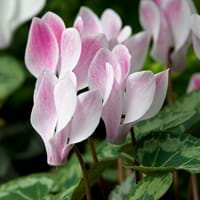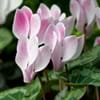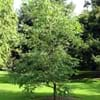Life Span
Perennial
Perennial
Type
Flowering Plants, Tubers
Flowering Plants
Origin
Europe, Mediterranean Basin, Middle East, North Africa, Somalia
Not Available
Types
Cyclamen Africanum, Cyclamen Alpinum, Cyclamen Cilicium, Cyclamen Coum
Aconitum napellus
Habitat
Alpine Meadows, Rocky areas, Woods
Damp shady woods, meadows
USDA Hardiness Zone
5-9
12-15
Sunset Zone
15, 16, 17, 18, 19, 20, 21, 22, 23, 24
21, 22, 23, 24
Habit
Clump-Forming
Oval or Rounded
Minimum Height
Not Available
Minimum Width
Not Available
Flower Color
Pink, Purple, White
Yellow
Flower Color Modifier
Not Available
Not Available
Leaf Color in Spring
Several shades of Green
Not Available
Leaf Color in Summer
Not Available
Not Available
Leaf Color in Fall
Green, Silver
Not Available
Leaf Color in Winter
Green, Silver
Not Available
Leaf Shape
Heart-shaped
Compound
Plant Season
Autumn, Spring, Summer, Winter
Not Available
Sunlight
Indirect sunlight
Not Available
Growth Rate
Medium
Very Slow
Type of Soil
Clay, Sandy, Well drained
Not Available
The pH of Soil
Acidic
Not Available
Soil Drainage
Well drained
Not Available
Bloom Time
Autumn, Spring, Summer
Spring
Repeat Bloomer
Yes
Not Available
Tolerances
Not Available
Not Available
Where to Plant?
Container, Ground, Pot
Ground
How to Plant?
From bulbs, Seedlings
reseeds
Plant Maintenance
Medium
Medium
Watering Requirements
Do not water frequently, It cannot sustain wet-feet, Keep the ground moist but not water-logged, Prefer drip-irrigation instead of Over-head watering, Water when soil is dry
Do not let dry out between waterings
In Summer
Lots of watering
Lots of watering
In Spring
Moderate
Moderate
In Winter
Average Water
Average Water
Soil pH
Acidic
Not Available
Soil Type
Clay, Sandy, Well drained
Not Available
Soil Drainage Capacity
Well drained
Not Available
Sun Exposure
Indirect sunlight
Not Available
Pruning
Cut or pinch the stems, Prune if you want to improve plant shape, Prune ocassionally, Prune to control growth, Prune when plant is dormant, Remove dead leaves, Remove dead or diseased plant parts
Remove damaged leaves, Remove dead branches, Remove dead leaves
Fertilizers
All-Purpose Liquid Fertilizer
All-Purpose Liquid Fertilizer
Pests and Diseases
Aphids, Botrytis Cinerea, Gray mold, Mice, Mites, Root weevil, Slugs, Snails, Squirrels
Red blotch
Plant Tolerance
Drought
Drought
Flowers
Yes
Not Available
Flower Petal Number
Single
Single
Fragrant Flower
Yes
Not Available
Fragrant Fruit
No
Not Available
Fragrant Leaf
No
Not Available
Fragrant Bark/Stem
No
Not Available
Showy Foliage
Yes
Not Available
Showy Bark
No
Not Available
Foliage Texture
Medium
Bold
Foliage Sheen
Matte
Not Available
Invasive
No
Not Available
Self-Sowing
Yes
Not Available
Attracts
Not Available
Hummingbirds
Allergy
Respiratory problems
poisonous if ingested, Toxic
Aesthetic Uses
Showy Purposes
Not Used For Aesthetic Purpose
Beauty Benefits
Not Available
Not Available
Environmental Uses
Air purification
Air purification
Medicinal Uses
Digestive disorders, Menstrual Disorders
Analgesic, Anodyne, Diaphoretic, Homeopathy, Used as a sedative
Part of Plant Used
Root, Stem
Root
Other Uses
Showy Purposes, Used as an ointment
Not Available
Used As Indoor Plant
Yes
No
Used As Outdoor Plant
Yes
Yes
Garden Design
Not Available
Not Available
Botanical Name
Cyclamen Persicum
Aconitum
Common Name
Cyclamen or Florist's Cyclamen
aconite, monkshood, wolf's bane, leopard's bane, mousebane, women's bane, devil's helmet, Queen of all Poisons, blue rocket
In Hindi
Sikalemen
बच्छनाभ
In German
Zyklamen
Eisenhut
In French
Cyclamen
Queen of all Poisons
In Spanish
Ciclamen
Queen of all Poisons
In Greek
κυκλάμινο
Queen of all Poisons
In Portuguese
Cíclame
Queen of all Poisons
In Latin
Cyclamīnos
Queen of all Poisons
Phylum
Anthophyta
Tracheobionta
Class
Dicotyledonae
Magnoliopsida
Order
Ericales
Ranunculales
Family
Primulaceae
Cactaceae
Clade
Not Available
Angiosperms, Eudicots
Tribe
Cyclamineae
Delphinieae
Subfamily
Myrsinoideae
Not Available
Difference Between Cyclamen and Queen of all Poisons
If you are confused whether Cyclamen or Queen of all Poisons are same, here are some features about those plants to help you choose better. Many people think that these two plants have the same characteristics, but one can see Cyclamen and Queen of all Poisons Information and learn more about it. Fertilizers required for proper growth of Cyclamen are All-Purpose Liquid Fertilizer, whereas for Queen of all Poisons fertilizers required are All-Purpose Liquid Fertilizer. Hence, one should know the basic difference between Cyclamen and Queen of all Poisons if you are planning to have them in your garden to enhance its beauty.
<
Flowering PlantsImportance of Cyclamen and Queen of all Poisons
Want to have the most appropriate plant for your garden? You might want to know the importance of Cyclamen and Queen of all Poisons. Basically, these two plants vary in many aspects. Compare Cyclamen and Queen of all Poisons as they differ in many characteristics such as their life, care, benefits, facts, etc. Every gardener must at least have the slightest clue about the plants he wants to plant in his garden. Compare their benefits, which differ in many ways like facts and uses. The medicinal use of Cyclamen is Digestive disorders and Menstrual Disorders whereas of Queen of all Poisons is Analgesic, Anodyne, Diaphoretic, Homeopathy and Used as a sedative. Cyclamen has beauty benefits as follows: Not Available while Queen of all Poisons has beauty benefits as follows: Not Available.
Compare Facts of Cyclamen vs Queen of all Poisons
How to choose the best garden plant for your garden depending upon its facts? Here garden plant comparison will help you to solve this query. Compare the facts of Cyclamen vs Queen of all Poisons and know which one to choose. As garden plants have benefits and other uses, allergy is also a major drawback of plants for some people. Allergic reactions of Cyclamen are Respiratory problems whereas of Queen of all Poisons have poisonous if ingested and Toxic respectively. Having a fruit bearing plant in your garden can be a plus point of your garden. Cyclamen has no showy fruits and Queen of all Poisons has no showy fruits. Also Cyclamen is flowering and Queen of all Poisons is not flowering . You can compare Cyclamen and Queen of all Poisons facts and facts of other plants too.





